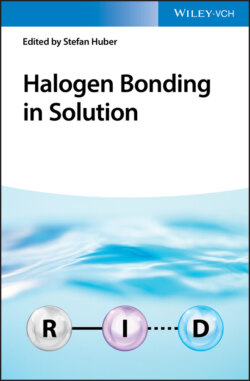Читать книгу Halogen Bonding in Solution - Группа авторов - Страница 12
1.1.1 The Halogen Bond: Definition, Characteristics, Representations, and Parallels to the Hydrogen Bond
Оглавление“A halogen bond occurs when there is evidence of a net attractive interaction between an electrophilic region associated with a halogen atom in a molecular entity and a nucleophilic region in another, or the same, molecular entity”
IUPAC definition 2013 [2]
The depiction of a covalently bound halogen atom in traditional textbooks is that of an electron‐rich sphere (Figure 1.1a). This simplified description is applicable in many cases and helps account for the behavior of covalently bound halogens as hydrogen bond acceptors [3] and their “side‐on” interactions with metal cations [4]. However, the electron density around halogens is not uniform; the distribution of electron density is anisotropic, resulting in two regions of electron density [5,6] (Figure 1.1b). The region directly involved in halogen bonding is the electropositive region at the tip of the halogen projected away from the covalent bond. This region is termed the sigma hole (σ‐hole), as it is a localized deficit of electron charge opposite a σ‐bond [7]. The second region is the electronegative belt, which forms orthogonal to the covalent bond involving the halogen atom. Thus, an electronic gradient on the surface of the halogen is formed, going from electropositive at the “tip” to electronegative around the equator. The electronic distribution is aptly demonstrated in Figure 1.2, which shows a series of molecular electrostatic potential (ESP) maps of trifluoromethyl halides [8]. Mapping halogenated species in this manner highlights the two distinct regions described above that engender the halogen bond with its characteristic directionality. For instance, if a Lewis base deviates from the σ‐hole region, the interaction becomes less favorable and eventually becomes repulsive as the Lewis base approaches the electron‐rich belt (Figure 1.1b). The σ‐hole is most prominent in the CF3I molecule and is depicted in this case as the red region of high ESP (Figure 1.2). The region can be quantified and compared with other systems by computing the maximum ESP (Vs,max) on the halogen.
Figure 1.1 Schematic of interactions between a halogen atom and a Lewis base acceptor (A) from a classical view of halogens (a) and from a modern halogen bonding description (b). For comparison the depiction of a hydrogen bond is also included (c). A solid arrow indicates a “stronger” attractive interaction. The dotted arrow is a “less” attractive interaction. The solid arrow with an “X” through it indicates the interaction is repulsive.
Figure 1.2 Molecular electrostatic potential maps drawn at the isodensity surface of 0.001 au for CF3I, CF3Br, CF3Cl, and CF4. All maps are drawn at the same scale, and values are in kcal/mol.
Source: From Clark et al. [8]. © 2007 Springer Nature.
Disclaimer: It is crucial to note that the σ‐hole description does not account for all the nuances of the halogen bond. Therefore, other conceptual approaches and methodologies (e.g. polarizability, charge transfer) can and should be used to fully describe the halogen bond. These particulars are discussed in the computational section of this chapter. Nevertheless, the σ‐hole is widely used, and ESP maps offer a low barrier to understand the general features and characteristics of the halogen bond.
